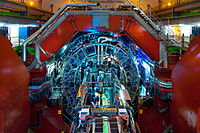
Photo from wikipedia
Purpose A novel fast neutron scatter camera with capabilities of neutron imaging and spectroscopy is under development. The detection principle is based on multiple neutron–proton (n–p) elastic scattering interactions in… Click to show full abstract
Purpose A novel fast neutron scatter camera with capabilities of neutron imaging and spectroscopy is under development. The detection principle is based on multiple neutron–proton (n–p) elastic scattering interactions in organic scintillator. In order to improve position measurement accuracy of recoil protons, a position-sensitive prototype detector unit has been designed and characterized experimentally. Methods The presented detector unit consisted of a plastic scintillator sheet of 10 cm × 10 cm × 1 cm dimensions and two groups (6 × 2) of wavelength-shifting fibers with orthogonal directions embedded into grooves on two opposite scintillator surfaces. Scintillation signals were read out by silicon photomultipliers (SiPMs). A collimated Sr-90 radioactive source was utilized for system calibration and position resolution measurement. Results Light output of the unidimensional six fiber channels from one side of the detector unit was calibrated to be 14.45 photoelectrons per MeVee. Position resolution of the detector unit was measured to be 0.35–0.44 times fiber pitch, corresponding to 5.48 mm for proton recoil energy interval of 1.63–2.60 MeV, and 4.60 mm for proton recoil energy interval of 4.82–5.50 MeV. Energy threshold for recoil proton localization was estimated to be 1.18 MeV. Conclusion The results shown satisfy basic requirements of the scatter camera, while space exists for further improvements. The positioning performance optimization consists of three aspects. The first one is to increase the fiber diameter so as to reduce signal loss. The second one is to depress dark rate of the SiPMs. The last one is to decrease the number of channels involved in position reconstruction by narrowing the scintillation signal distribution function of the detector unit.
Journal Title: Radiation Detection Technology and Methods
Year Published: 2020
Link to full text (if available)
Share on Social Media: Sign Up to like & get
recommendations!